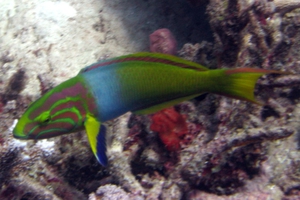Description
Also known as Banana Wrasse, Bluefin Wrasse, Green Moon Wrasse, Lime Green Wrasse, Lunate-tailed Wrasse, Sunset Wrasse, Surge Wrasse, Whistling Daughter, Yellow-green Wrasse, Yellow Moon Wrasse, Yellow Wrasse.
Found in schools, over dense coral, rubble, and sandy areas, of shallow, exposed, clear lagoons, and seaward reefs, rich in coral growth.
They feed on fish eggs, benthic invertebrates, and worms.
Length - 25cm
Depth - 1-30m
Widespread Indo-Pacific
Most reef fish seen by divers during the day, are grazers, they cruise around, just above the surface of the coral, or snoop into crevices, foraging for food.
Wrasses have small protruding teeth, which they use to graze the bottom, taking in a variety of algae, crustaceans, such as crabs, eggs, shrimps, snails and worms. Any hard coats or thick shells, are then ground down by their pharyngeal jaws, and the delicacies inside digested.
From juvenile to adult, wrasses dramatically alter their colour and body shapes.
Wrasses are always on the go during the day, but are the first to go to bed and the last to rise.
Small wrasses dive below the sand to sleep, and larger wrasses wedge themselves in crevices. Ref: https://www.fishbase.se/summary/Thalassoma-lutescens










2 comments
Posted by @fishx6No that is not typical especially for a juvenile as they tend to be darting about the reef. Moreover this fish is not found in the mediterranean and so maybe another type of fish which would be more friendly!
Posted by Bill standardI've just seen one of these in shallow water off the Mediterranean island of Ibiza. About 10cm kind and it but me. It was very bold and didn't run when I moved my hand close. Any one know if that's typical?